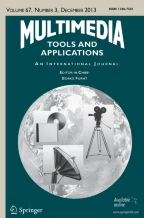1631Accesses
43Citations
Abstract
In the domain of emergency management, in addition to the constant technical skill-upgrade required by the nature of the humanitarian context, the importance of an appropriate training is widely recognized. In particular, giving responders information technology skills so that they are well prepared to address health, security and managerial concerns represents a key factor by which the goal of an efficient and effective humanitarian emergency response can be pursued. In this paper we propose the adoption of augmented reality mobile interfaces to enhance the training efficacy for on-site crisis preparedness activities. The system we propose originated from the idea to allow trainees to exploit Augmented Reality (AR) interaction and become quickly familiar with the mobile technology adopted today in emergency response activities.
This is a preview of subscription content,log in via an institution to check access.
Access this article
Subscribe and save
- Get 10 units per month
- Download Article/Chapter or eBook
- 1 Unit = 1 Article or 1 Chapter
- Cancel anytime
Buy Now
Price includes VAT (Japan)
Instant access to the full article PDF.







Similar content being viewed by others
Explore related subjects
Discover the latest articles and news from researchers in related subjects, suggested using machine learning.References
Aedo, Bañuls, Canós, Díaz, Hiltz (2011) “Information technologies for emergency planning and training” in Proceedings of the 8th International Conference on Information Systems for Crisis Response and Management - ISCRAM. Lisbon, 8–11 May 2011. pp. 1–5.
Bañuls V, Zarraonandia T, Aedo I, Díaz P, Murray T (2014) “A scenario-based virtual environment for supporting emergency training,” in Proceedings of the 11th International Conference on Information Systems for Crisis Response and Management - ISCRAM. University Park, Pennsylvania, 597–601 May 2014
Carver L, Turoff M (2007). “Human computer interaction: The human and computer as a team in emergency management information systems,” in Communications of the ACM - Emergency response information systems: emerging trends and technologies. ACM New York, NY, USA Vol 50(3), pp. 33–38.
De Chiara D, Paolino L, Romano M, Sebillo M, Tortora G, Vitiello G (2010) “LINK2U: connecting social network users through mobile interfaces” in Proceedings of IEEE PCM 2010 Advances in Multimedia Information Processing - September 21–24, Shanghai, China. Lecture Notes in Computer Science, Guoping Qiu, Kin-Man Lam, Hitoshi Kiya, Xiangyang Xue, C.-C. Jay Kuo, Michael Lew (eds.) PCM 2010, Part II, LNCS 6298, pp. 583–594, 2010. © Springer-Verlag Berlin Heidelberg 2010.
Drabek TE (2003) Strategies for Coordinating Disaster Responses (Monograph No. 61, Program on Environment and Behavior, 242 pp.) Boulder, CO: University of Colorado, Institute of Behavioral Science.
Ginige A, Paolino L, Romano M, Sebillo M, Tortora G, Vitiello G (2014) “Information Sharing among Disaster Responders - An Interactive Spreadsheet-Based Collaboration Approach”, in Computer Supported Cooperative Work (CSCW), 23 (4–6), 2014, pp. 547–583. ISSN: 0925–9724
Jackson BA, Baker JC, Ridgely MS, Bartis JT, Linn HI (2004) Protecting emergency responders. Safety Management in Disasters and Terrorism Response, vol. 3: Safety management in disaster and terrorism response. Department of Health and Human Services: National Institute of Occupational Safety and Health Publication No. 2004-144, Cincinnati, OH
Jennex ME (2004) Emergency response systems: the utility Y2K experience. J Inf Techno Theory Appl 6(3):85–102
Johnson WL, Rickel J, Stiles R, Munro A (1998) Integrating pedagogical agents into virtual environments. Presence: Teleoperators and Virtual Environments 7(6):523–546
Paolino L, Sebillo M, Tortora G, Vitiello G (2008) Framy - visualising geographic data on mobile interfaces. J Locat Based Serv 2(3):236–252
Paolino L, Romano M, Sebillo M, Tortora G, Vitiello G (2009) Audio-visual information clues about geographic data on mobile interfaces. Advances in Multimedia Information Processing-PCM 2009. Lect Notes Comput Sci 5879:1156–1161
Paolino L, Romano M, Sebillo M, Vitiello G (2010) Supporting the on site emergency management through a visualization technique for mobile devices. J Locat Based Serv 4(03–04):222–239. doi:10.1080/17489725 Taylor and Francis Group Ltd.
Petak WJ (1985) Emergency management: a challenge for public administration. Public Adm Rev 45(1):3–7
Toups ZO, Kerne A, Hamilton WA (2011). The Team Coordination Game: Zero-fidelity simulation abstracted from fire emergency response practice. ACM Trans Comput-Hum Interact. 18, 4, 37 pages. doi:10.1145/2063231.2063237
Author information
Authors and Affiliations
Department of Computer Science (DI), University of Salerno, I-84084, Fisciano, SA, Italy
Monica Sebillo & Giuliana Vitiello
University of Western Sydney, Sydney, Australia
Luca Paolino
Link Campus University, Rome, Italy
Athula Ginige
- Monica Sebillo
Search author on:PubMed Google Scholar
- Giuliana Vitiello
Search author on:PubMed Google Scholar
- Luca Paolino
Search author on:PubMed Google Scholar
- Athula Ginige
Search author on:PubMed Google Scholar
Corresponding author
Correspondence toGiuliana Vitiello.
Rights and permissions
About this article
Cite this article
Sebillo, M., Vitiello, G., Paolino, L.et al. Training emergency responders through augmented reality mobile interfaces.Multimed Tools Appl75, 9609–9622 (2016). https://doi.org/10.1007/s11042-015-2955-0
Received:
Revised:
Accepted:
Published:
Issue Date:
Share this article
Anyone you share the following link with will be able to read this content:
Sorry, a shareable link is not currently available for this article.
Provided by the Springer Nature SharedIt content-sharing initiative


